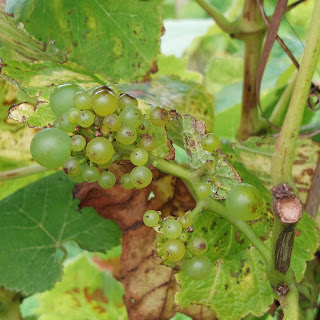 |
Alex holding a small bunch
|
Hey, great news. We had our first grape harvest after 5 years of waiting on Saturday, September 19th. This is what it looked like. The bags seemed to work. We had a sort of double-blind comparison. We bagged many but left some. The bagged ones were much nicer than the unbagged ones which seemed to have been largely picked by the birds again. Some of the ones that hadn't been eaten, looked like raisins. But we got a yield of three buckets from the 5 vines.
 |
About 3 buckets worth from 5 Rondo vines
|
I think we really did not expect a harvest as we hadn't read up on how to use the equipment I had bought last year. Our starter kit contained 2 monstrously large plastic vats (when compared to the volume of grapes), some sterilizer, a stirring paddle, some tubing, a sampling pipette, yeast packet, bottle washer, and hydrometer and graduated glass test cylinder. It did not contain Campden tablets. Campden Tablets are sodium metabisulphate, which prevents oxidation and bacterial infection when bottling wine or cider. It provides long term stability to the brew. So we are going without them for the first phase.
Sulfites comprise a range of sulfur compounds -- particularly sulfur dioxide (SO2) -- that are a natural by-product of the fermentation process. They work as a preservative against certain yeast and bacteria which will quickly destroy a wine if they start to multiply. But fermentation alone doesn’t produce enough sulfite to preserve a wine for more than a few weeks or months in the bottle, so winemakers add extra in order to keep microbes at bay. A well-made dry red wine typically has about 50 mg/l of sulfites. Wines with lower acidity need more sulfites than higher acidity wines. At pH 3.6 and above, wines are much less stable, and sulfites are necessary for shelf-life.
I sterilised all the equipment per instructions I found online, and I washed the grapes and discarded any that were unsuitable. A few were mouldy, so I picked them off and washed the rest. I hope that's what one does. Alex picked the grapes off the stems and put them in the sterilized vat.
I had bought a book for beginner winemakers and at least we found a recipe and instructions. We crushed the grapes partly by hand, and then I used the flat end of my wooden meat mallet, sterilized, of course, to complete the press. We were going to use the apple press but were advised against that by the book.
The specific gravity was 0.9 and the goal was 1.09, so we estimated the amount of sugar water required and got to 1.1 on the first try. We were pleased with that. I placed the lid on with the airlock engaged. It's good to have the first try of winemaking on a small batch.
I ordered Campden tablets for the next phase so hopefully, we will be okay if whatever contaminant doesn't destroy the must. Plenty of people don't use Campden tablets if they are producing wine with naturally occurring resident yeast. I've also now ordered a 5L demijohn for the next stage and a second of everything that could be easily broken per the advice of another knowledgeable blogger. So now we stir and wait.
 |
Perfect little packages and very sweet
|
 |
Some were picked clean
|
 |
A few weren't quite ripe
|
 |
Some even unbagged were lovely
|


































